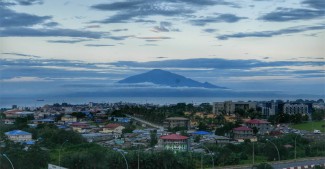|
|
|
Over the past four years, Ibrahima Sittina Farate from Comoros has grown her essential oils and beauty products company, Biozen, gaining key business and marketing skills along the way. But without access to trade finance, this ambitious entrepreneur is cut off from export markets.
Farate is not alone: according to the World Economic Forum (WEF), trade finance is one of the top three export obstacles for half of the world’s countries, and notably the poorest.
When it comes to cross-border trading, entrepreneurs know that access to trade finance is crucial to success. Exporters want to be paid upon shipment, while importers want to pay when they receive goods.
For centuries, bankers have filled this time gap through trade finance, or credit that covers the risk of non-payment. This risk is small – 0.2% on average globally with little variation across countries – making trade finance a low-cost source of funding. Today, an estimated 80% of global trade is covered by credit or a short-term payment guarantee, with over $10 trillion in annual flows, according to the Bank of International Settlements.
But in some countries there is a large gulf between supply and demand. According to the Asian Development Bank, the current trade finance gap, or the amount of requested trade finance that is rejected, is estimated at $1.5 trillion globally. Half of this is in developing countries in Asia and Africa, with small and medium-sized enterprises (SMEs) suffering the most. The WEF estimates this gap could reach $2.5 trillion by 2025 as supply chains move away from China to poorer developing countries. This not only puts up a major wall between global markets and the SMEs that are otherwise ready to supply them, it also prevents trade from fulfilling its potential to promote growth and development and create jobs.
Why is there such a large trade finance gap in developing countries?
Trade finance is often taken for granted in industrialized countries, because importers and exporters are backed by mature financial industries. But in developing countries, requests for trade finance are more likely to be rejected, for several reasons.
Recognition of creditworthiness is more difficult for companies that cannot provide collateral or detailed financial documentation. And, local traders may only have available a smaller, more selective financial industry. Another key challenge is that in many developing countries there is limited access to the knowledge and skills needed to handle trade finance instruments.
Add to this the fact that, since the 2008–09 global financial crisis, international banks have been shrinking their networks of correspondent banking relationships, which they use to clear cross-border payments and guarantees. From over a million such relationships before the crisis, a total of 200,000 have disappeared, affecting trade finance flows to Africa, the Caribbean, Central and Eastern Europe and the Pacific Islands the most.
The financial system has become even more concentrated since the adoption of new regulations to stifle money laundering and counter the financing of terrorism, as well as regulations on trade and financial sanctions.
Least developed countries are hardest hit
The situation in the least developed countries is dire. The rejection rate for requests of trade finance in Africa exceeds 50%, while the trade finance gap is estimated to be more than $100 billion annually – one-third of the total market value. With few alternatives to bank financing, traders generally abandon the transaction once rejected. Many international banks no longer support cross-continent trade transactions with Africa, for fear of regulatory fines. As a result, finding US dollars to clear trade transactions has become a challenge for local banks.
As shown by Cambodia’s Trade Integration Strategy 2019–2023, SMEs account for 90% of exports. Because of the lack of trade finance, exporters must pay for their inputs in advance, and local lending is collateralized by land – thereby excluding landless, cashless businesses from accessing essential trade finance. This same story plays out in many other economies.
Ways forward
In cooperation with the Government of Cambodia, the World Trade Organization (WTO) has developed recommendations for alternatives to bank financing such as factoring and credit insurance. More broadly, it has been building a coalition of institutions to address the problem and get the international community’s attention to trade finance shortages. In 2016, the Director-General of the WTO, Roberto Azevêdo, spelled out priority actions for the world in a publication on trade finance:
1. Support multilateral development banks' trade finance facilitation programmes through advocacy and mobilization;
2. Reduce the knowledge gap regarding trade finance products by encouraging WTO partners to increase their training programmes;
3. Open a dialogue with trade finance regulators.
Each of these areas has seen progress.
Multilateral development banks have increased financing and/or guarantees in the poorest parts in the world. In 2018, these programmes supported around $30 billion in trade transactions in low income countries, a 50% increase since 2016, with a greater focus on SMEs. To help close knowledge gaps at local financial institutions, the WTO, along with multilateral development banks and the International Chamber of Commerce, have trained more than 1,500 people across 60 countries, each year. To increase dialogue with regulators, Azevêdo has reached out to the heads of the Financial Stability Board and the International Monetary Fund to develop practical steps to help trade finance providers come to grips with regulatory demands.
The WTO is ready to work with partners to pursue more solutions to the trade finance gap, with a more systematic approach to certain regions in terms of diagnosis, recommendations and capacity-building.
Clearing the obstacles between global markets and the SMEs that have the goods people around the world want will not only help individual exporters, it will help trade live up to its potential, and least developed countries to gain the benefits they desperately need.
----------------------
Originally published in World Economic Forum Agenda on 10 February 2020
Header image - ©REUTERS/Rodrigo Garrido
If you would like to reuse any material published here, please let us know by sending an email to EIF Communications: eifcommunications@wto.org.




